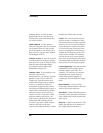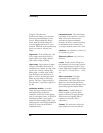
217
Glossary
machine because the master card is
in slot C of the mainframe. The other
cards of the module are called
expansion cards.
menu bar The menu bar is located
at the top of all windows. Use it to
select File operations, tool or system
Options, and tool or system level
Help.
message bar The message bar
displays mouse button functions for
the window area or field directly
beneath the mouse cursor. Use the
mouse and message bar together to
prompt yourself to functions and
shortcuts.
module/probe interconnect cable
The module/probe interconnect cable
connects an E5901B emulation
module to an E5900B emulation
probe. It provides power and a serial
connection. A LAN connection is also
required to use the emulation probe.
module An instrument that uses a
single timebase in its operation.
Modules can have from one to five
cards functioning as a single
instrument. When a module has more
than one card, system window will
show the instrument icon in the slot
of the master card.
monitor When using the Emulation
Control Interface, running the
monitor means the processor is in
debug mode (that is, executing the
debug exception) instead of
executing the user program.
panning The action of moving the
waveform along the timebase by
varying the delay value in the Delay
field. This action allows you to
control the portion of acquisition
memory that will be displayed on the
screen.
pattern mode In an oscilloscope,
the trigger mode that allows you to
set the oscilloscope to trigger on a
specified combination of input signal
levels.
pattern terms Logic analyzer
resources that represent single states
to be found on labeled sets of bits; for
example, an address on the address
bus or a status on the status lines.
period (.) See edge terms, glitch,
labels, and don't care.
pod pair A group of two pods
containing 16 channels each, used to
physically connect data and clock
signals from the unit under test to the
analyzer. Pods are assigned by pairs
in the analyzer interface. The number
of pod pairs available is determined


















